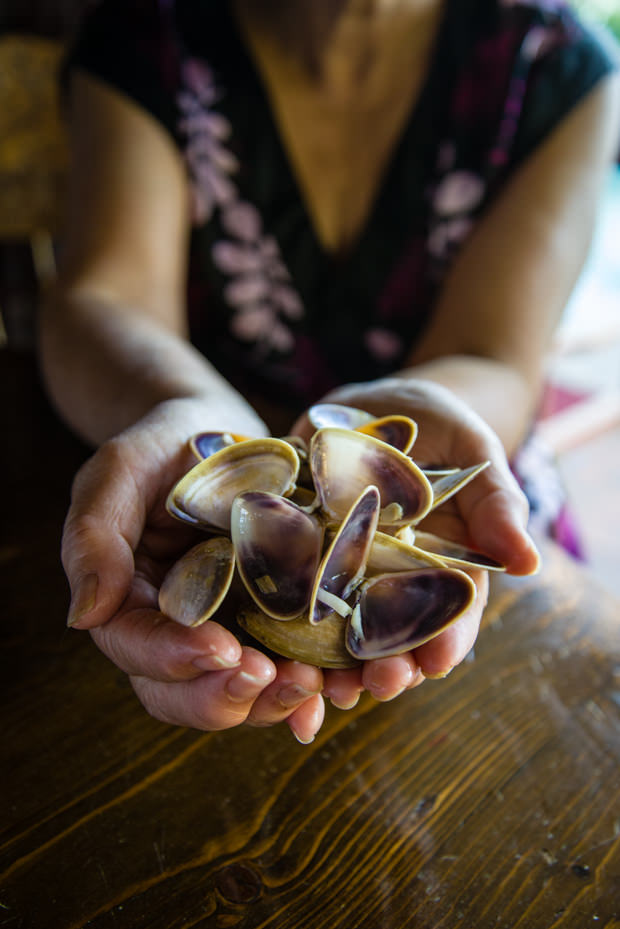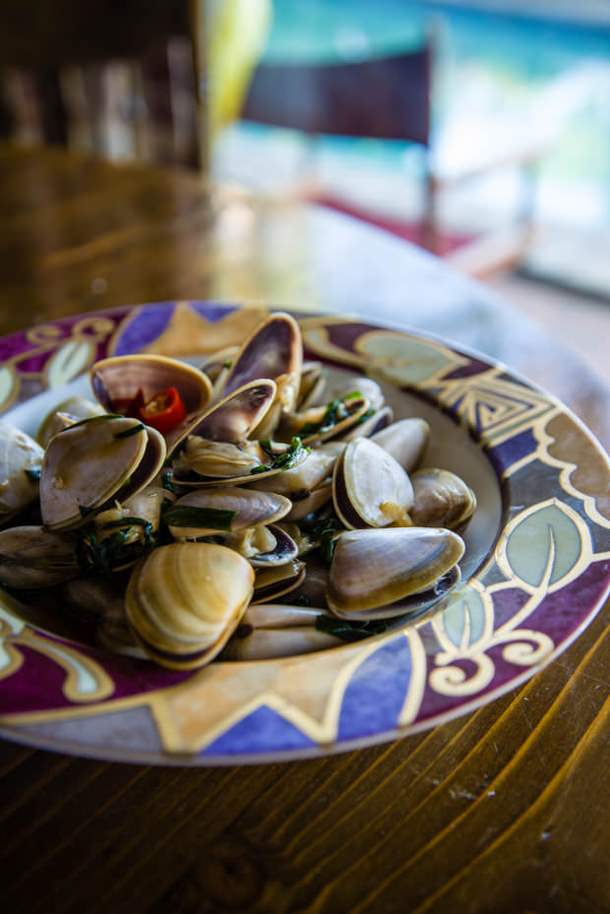
Happy New Year everyone!
We spent the last day of 2012 cockling at Goolwa Beach and it reminded me of this story I wrote three years ago about my childhood cockling trips. So I thought I’d share it with you today. I hope you like it and I’d love to hear about your favourite childhood food memories via the comments.
The photos were taken yesterday at the beach (Iphone and DSLR) and today at my parent’s house.
Christina xx
Cockling at Goolwa Beach
When I was a young girl the summer holidays stretched out endlessly.
We spent most of the long, lazy days in our salt-water swimming pool. We picked nectarines, peaches and loquats straight from our own trees when we wanted a snack and most nights we ate barbeque dinners outside on our patio, going to bed with full tummies and sun-warmed skin. It was a blissfully uneventful time.
However, nothing made me happier than my Dad saying five simple words: “kids, we’re going cockling tomorrow.”
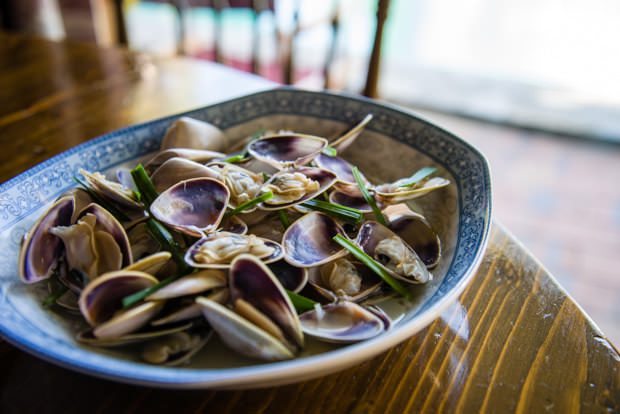
Cockles or pippis are a type of clam, a mollusc. Related to the oyster and mussel they taste not unlike a razor clam. Encased in a simply hinged triangular shaped shell that ranges in colour from the palest white through to apricot and then to dark grey, they were then known in Australia primarily as fish bait.
We, being cunning Asians, knew better. Stir-fried with a handful of choice ingredients, the humble cockle was superb. Added to fried noodles or a fiery coconut laksa, they added a savoury flavour that was at once distinctive and complementary. But best of all, they were free, ours for the taking from their home underneath the sands of Australia’s public beaches.
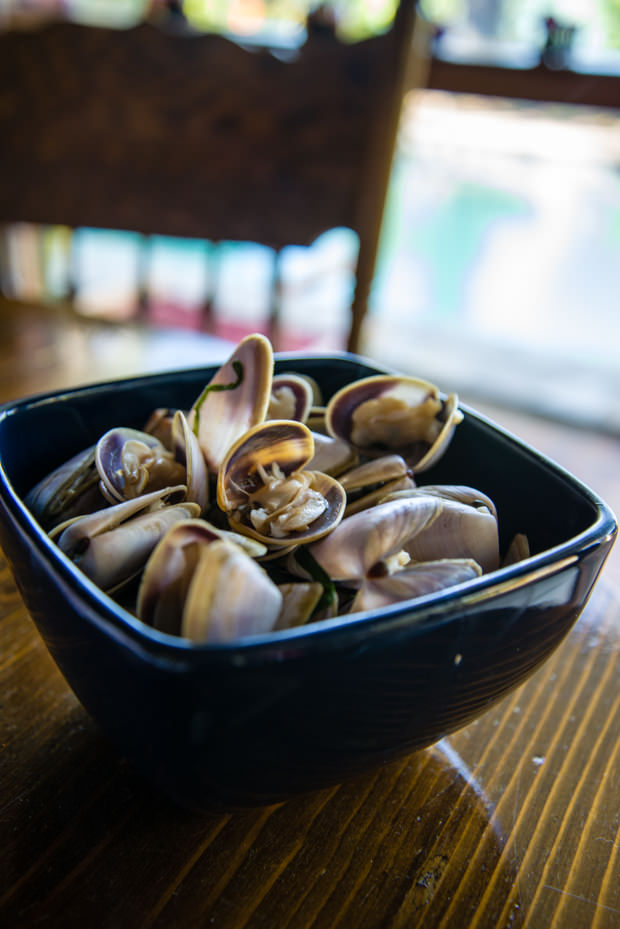
The beach we always went to, Goolwa Beach, was about an hour’s drive from Adelaide down the Southern coast. Known more as a surfer’s beach, it stood on the edge of the town of Goolwa. Once a thriving Riverport Goolwa was now an easy-going township popular with fisherman and boating enthusiasts.
Having decided what day to go, Dad would then ‘phone up our friends to join us. Having come originally to Australia as students in the late 60s, gaining citizenship in the early 70s, my parents’ friends were a mixture of chums from university, fellow migrants from Hong Kong, Malaysia and Singapore, people from church and neighbours. So accompanying us tomorrow will be the Birds, Chongs, Fittocks, and Wees: 10 adults and 12 kids in total.
The next morning we rise early, excited as if it were Christmas. My brother and I help our parents find bathers, towels, buckets and spades, sunscreen, hats and thongs. Mum packs drinks, snacks and utensils into the eski while Dad fries some mee hoon — delicious rice noodles with strips of meat, bean sprouts and garlic — in his battered wok.
A convoy of cars filled with our friends follows us from Adelaide down to Goolwa. We pass highways, forests, small country towns, cows and horses in fields. We kids sing songs at the top of our voices until the adults beg for mercy, play endless games of I Spy and yell ‘tractor’ every time we spot one.
Soon we arrive at the small town of Goolwa. Bypassing the main street, dotted with cafes and galleries, we head straight for the beach. The beach car park is always full of tall, bronzed boys with sun-bleached hair watching the waves from the hoods of their cars, their wetsuits pulled down around their snake-liike hips. Young girls in bikinis and shorts lie on the sand and work on their tans, while out in their water the surfers bob up and down on their boards, untiring in their search for the perfect wave.
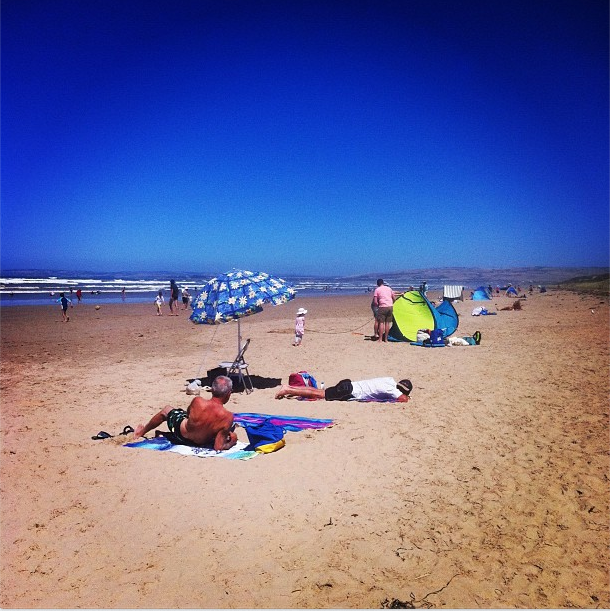
However we have not come here to surf. Leaving the main car park, our convoy continues on down a narrow road running parallel to the beach until we reach the car park of a national park, some ten kilometres away. There, we leave the cars and unload our gear before walking three kilometres over gently sloping sand dunes encrusted with salt and shells. The sun beats down on our heads and we begin to sweat. Our bare feet crunch as we walk on the broken shells, quickening our pace as the roar of the ocean becomes louder.
As we reach the crest of the last sand dune the Great Southern Ocean is a stunning sight – miles and miles of pristine golden sand being continually pounded by churning blue waters. There is hardly anyone else on this strip of beach, just a couple of families with kids, an older couple walking hand in hand, and a few loners meandering up and down, scanning the sand for possible treasure.
While the adults proceed at a more dignified pace, we kids dump our towels, kick off our thongs and hastily strip down to bathers. Impatient for the water, we run full-pelt down the beach towards the breaking waves, the sand burning hot beneath our feet.
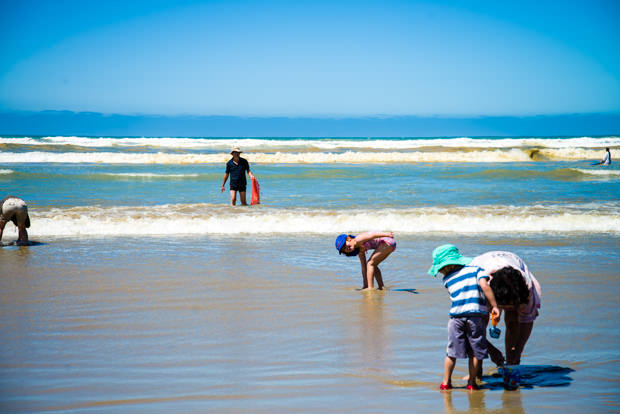
We go in. The water is heart-stoppingly cold. We shriek and exclaim, splashing each other and flinging sand about. But there is serious work to do and we soon settle down, taking up our positions along the beach.
We scrabble around on our hands and knees in the shallow surf while digging into the wet sand with our fingers and toes. The cockles are usually buried 5-20 centimetres beneath and we wriggle our toes deeper in the sand. The tide works with us as it sucks the waves in and out, taking the sand with it.
Soon… success! I can feel something smooth, hard and unyielding between my toes. Dropping down to all fours, I dig with my hands until I uncover a fat, plump cockle. It’s a good size, at least six centimetres long. There is a minimum legal length of three and half centimetres so this one is well over.
I feel around where the cockle was buried as you can often find a cluster buried together. My diligence is rewarded as I unearth another three good-sized cockles. I examine them carefully for chips or cracks before stowing them safely away in a plastic net bag that once held a kilo of oranges.
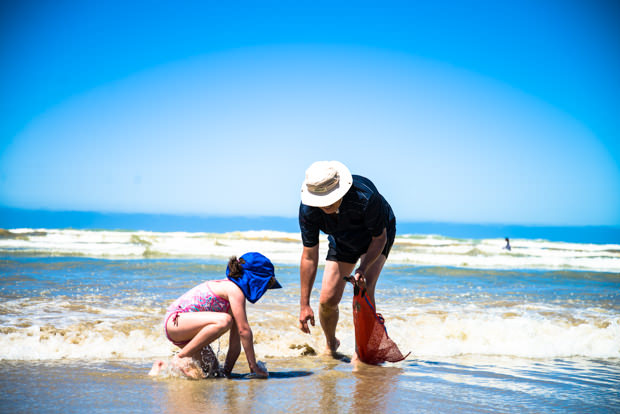
Sometimes you barely have to dig before the cockles are revealed by the tide drawing out. Then the cockles gently roll back with the water before coming to a stop. Nakedly exposed on top of the sand, they are ready to be simply picked up. But they do not give in without a fight; turning on their side they use their single muscle to try to burrow back under the sand.
Occasionally, too, you will reach down to pick up what you thought was a cockle only to receive a sharp pinch on your fingers, having unwittingly disturbed a hermit crab. These funny-looking crustaceans have long, soft abdomens that they protect with a salvaged seashell that their whole body can retract into. As they grow too big for one shell, they simply discard it and find another, roomier shell.
As we wade further out, from knee high to thigh high water, the waves grow stronger. Here, you have to brace yourself against the pull and tug of the tide, digging your heels firmly into the mud-like sand to stop yourself falling over. Inevitably though, when your attention is elsewhere, an errant wave will topple you over, seizing you and dragging you many metres inland until it deposits you unceremoniously on the beach. After a day of cockling my bathers are always full of sand.
From time to time we head back inland to where the adults have set up a makeshift camp on dry sand. Cockling is thirsty work so we noisily guzzle a soft drink, before grabbing a bowl of mee hoon, eating it quickly with clattering chopsticks. It’s getting hotter so we are careful to reapply sunscreen – we’ve all been burnt viciously before.
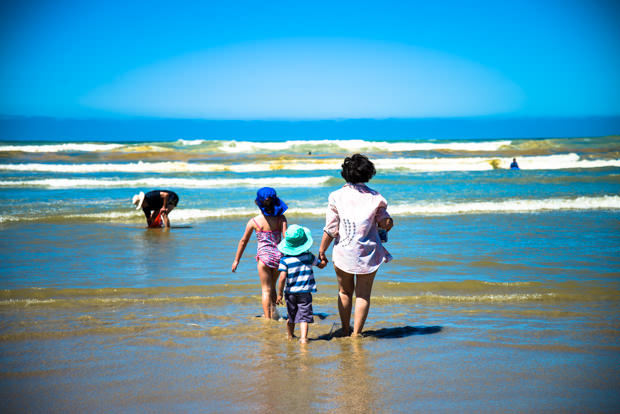
Some of the kids get bored with cockling, and start play-fighting and swimming in the water. Others start a game of beach cricket with a tennis ball and bat..
Legally, we are allowed 300 cockles per person but we never take anywhere near the limit; we take only what we can eat in one meal. So, after collecting a few hundred cockles, we fill up the eski with extra seawater and call it a day. Buoyed by our success, we retire to Goolwa’s main street where we head straight to local fish and chip shop.
We then drive back to Adelaide, again in convoy, all the kids swapping seats and cars again. Everyone comes back to our house to swim and relax while we wait for the cockles to spit out their sand.
In the pool we pretend to be mermaids and orca whales. We play Marco Polo, a game of water-tag/hide and seek, which everyone cheats at, and practise our best dive-bombs and belly-flops.
Later, my Dad heats up the barbeque and the men stand around chatting, beers in their hands, while the women prepare the salads and dishes that will make up the rest of the meal. The large round table under the patio is soon covered with what seems like all the bounty of the land.
Lamb chops, sausages, garlicky chevapchichis and honey-soy chicken wings are accompanied by creamy potato salad, slices of buttered crusty baguette, crisp green salads, beautifully pink watermelon and a tangy macaroni salad. Bottles of chilli sauce and sambal stand beside the usual tomato sauces and chutneys.
As dusk approaches, the air is heavy with the scent of flowers and the mosquitos drone steadily around us. When the meat is sizzling on the barbeque, Dad begins to cook the cockles.
Heating up his wok on his homemade outdoor stove until it is smoking hot, Dad fries garlic, onions, birds eye chillis, soy sauce, sugar, and black beans, turning them quickly with a metal spatula. The fragrant smell rises up in the air and we automatically take deep breaths while the chilli catches at the back of our throats.
Once the mixture is bubbling furiously Dad tips in a colander of live cockles. The wok hisses and spits as they hit its inky depths and steam rises up angrily, temporarily engulfing him. The cockles begin to open, the shells gaping to reveal the creamy meat inside.
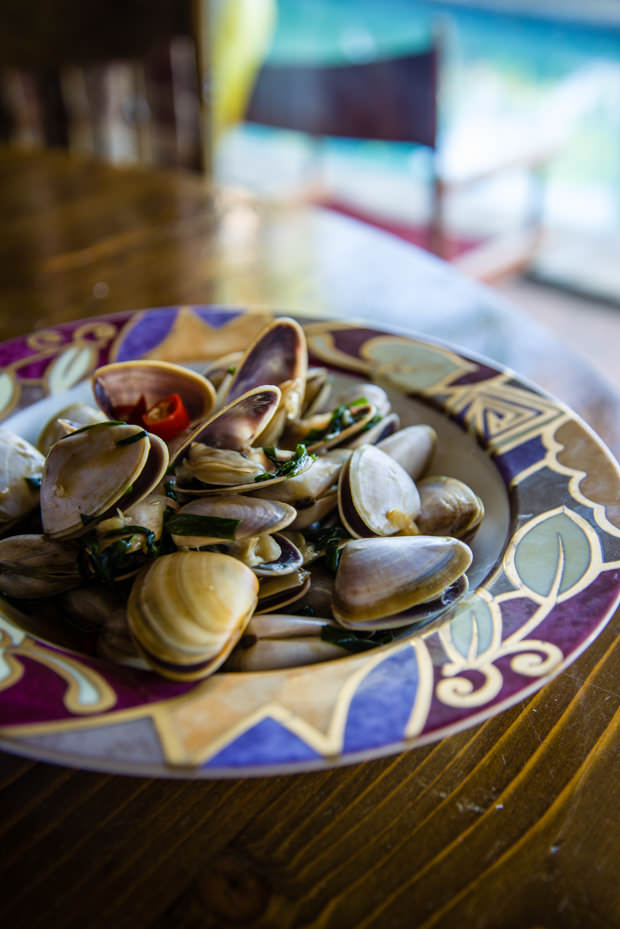
After a minute most of the cockles are open. The unopened ones will be discarded, in case the cockle is ‘off’ or dead. Dad tips the wok’s contents onto a huge platter and we hunter-gatherers feast, eating ravenously with our hands and using the empty shells to scoop up the salty sauce and carry it to our mouths. We slurp the savoury juices and lick the shells clean, reluctant to miss a bite, our mouths tingling with chilli.
It is a delicious end to a perfect day.
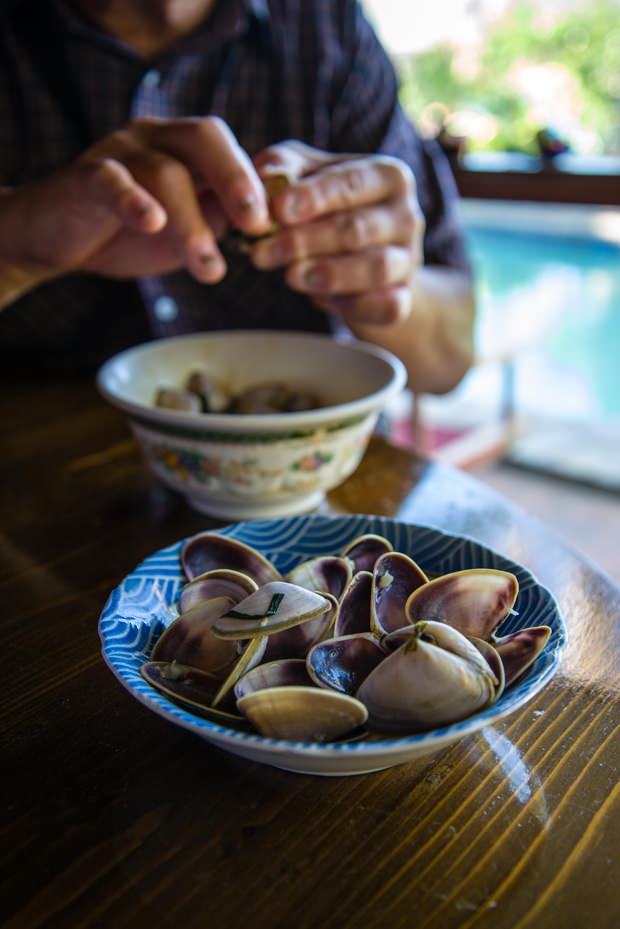
*****************************************
4 cockle recipes to try at home
Cockles with Garlic
To a saucepan add one tablespoon oil and then one clove minced garlic. Tip in the cockles, pour in 1/4 cup water and then put the lid on. Cook for a couple of minutes until the shells open up.
Cockles with Oyster Sauce
As above but add one tablespoon oyster sauce when you add the water and stir to combine.
Cockles with Bean Paste & Chilli
Heat up a large fry pan or work and then add one tablespoon oil, one clove minced garlic and one small diced onion. Fry for a minute or two and then tip in cockles. Add one teaspoon ground bean paste, one teaspoon sugar, 1-2 sliced Birds Eyes chillies and a few sliced spring onions. Pour in 1/2 cup water and then add a slurry of 1 teaspoon cornflour and 2 tablespoons water to thicken the sauce. Cook, stirring occasionally, over high heat until shells open.
Cockles with Lemongrass, Chilli & Basil
Heat up a large gry pan or wok and then add one tablespoon oil, one clove minced garlic and one small diced onion. Fry for a minute or two and then add one (pounded and cut) lemongrass stalk, 1-2 sliced Birds Eyes chillis, 1 tablespoon light soy sauce and a handful of fresh basil leaves. Add 1/4 cup water and then cook, stirring occasionally, over high heat until shells open.
